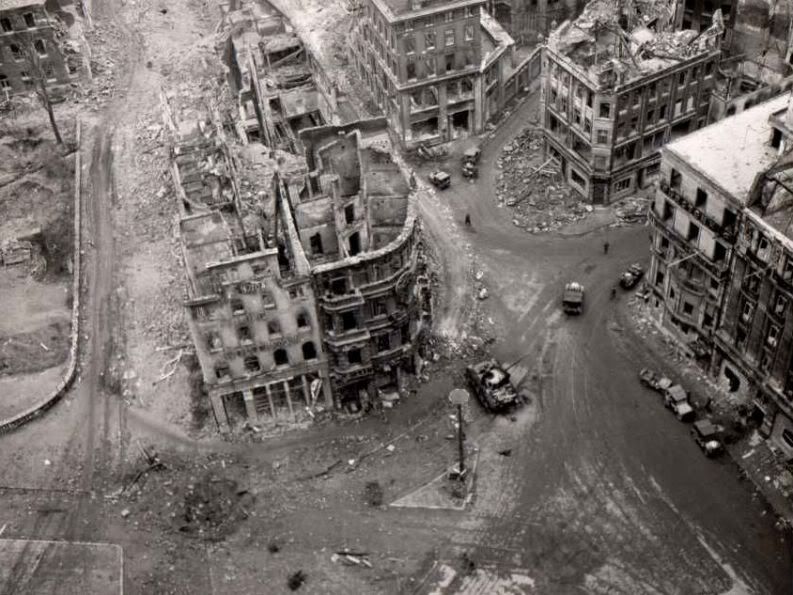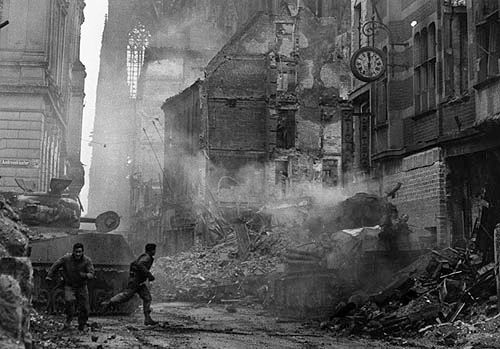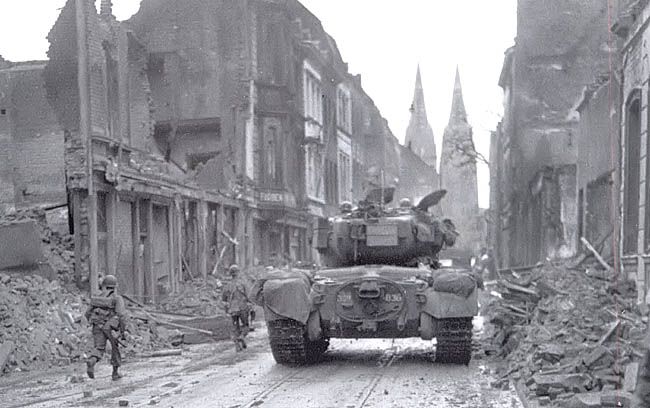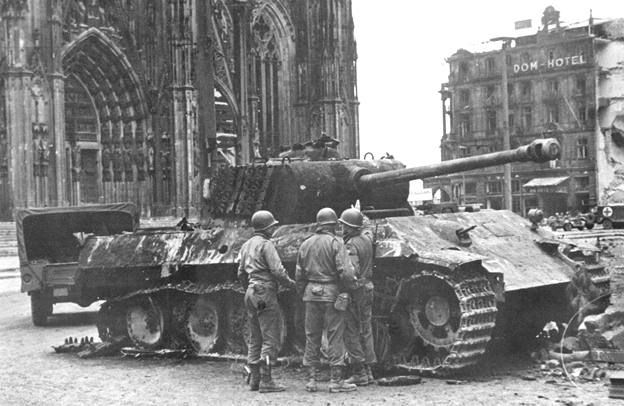A Morte de um Panther (Colónia, Alemanha, Março de 1945)
Uma história passada no final da WWII, ETO (Teatro Europeu de Operações), e que sinto vontade de partilhar.
A historia do Panther 131 (Ausf.A), II./Pz.Rgt. 33, 9 Pz.Div., e dos eventos dramáticos que levaram ao seu fim trágico, num embate final contra o T26E3 Pershing do Sgt. Robert Early, E Company, 32nd Arm.Rgt., 3rd Arm.Div «Spearhead», durante a tomada de Colónia, 6 de Março de 1945.
Irão encontrar de seguida imagens e videos sobre este trágico evento.
Uma vista sobre o largo da Catedral de Colónia, onde o desenlace final desta historia ocorreu:
Tudo se inicia com o abate de dois Shermans, por parte do Panther 131, com resultados trágicos para 4 membros dos tanques aliados:
Em resposta, temos o embate final entre o M26 Pershing e o Panther, e o fim trágico do tanque alemão e da sua tripulação, após 3 hits mortais:

Algumas páginas com mais imagens deste embate:
Pictures From Newsreal Footage With M26 Knocking Out Panther In Cologne
- http://home.earthlink.net/~crcorbin/ColognePictures.html
- http://home.earthlink.net/~3adspearhead/ColognePictures.html
Mise à mort d'un Panther par un Sherman en Allemagne
- http://perso.wanadoo.fr/did.panzer/Mise_mort_panther.html
Mais do que as imagens, nada mais realista do que o relato de soldados envolvidos nestes trágicos eventos, e ver em filme como o fim ocorreu:
Cologne Panther ~ History Channel [ 17Mb ]
(este vale mesmo a pena, pela força dos relatos e das imagens...)
Cologne Panther ~ Spiegel.TV
(as imagens do fim...)
Um excerto retirado de um grupo de discussão:
This is a pretty grizzly bit of footage to watch both for the poor old Sherman crewy with the smoking stump where his lower leg was and to see the Panther crewy get cooked as his vehicle goes up. But "After the Battle" Mag No.104 covers this the incident pretty throughly and adds a few more pieces to the puzzle along with a ton of pics. Though there are a lot of shots around in numerous books of this Panther taken after the incident burnt out in the square in various positions presumably after being shunted around a bit.
Apparently this lone Pz.Rgt.33 Panther either had mechanical trouble or was left behind as a rearguard in the Cathederal square down Marzellan Strasse and was simply "playing Possum". To the approaching US tanks in Komödien Strasse it appeared to be KO'd or abandoned with its gun depressed and turret turned away, before suddenly traversing its gun to their horror which is how it managed to take out the first 2 Shermans at such a close range killing 3 of the crew from at least one in the process.
The Sherman crewman who lost a leg from the Panther hit was apparently the Gunner not the TC according to the article. He was carried by the Bow Gunner Oliver Griffin who had himself also been blown out of his own hatch by the blast but was amazingly uninjured. Thus by elimination the TC was therefore killed along with the driver and loader if 3 men died.
The nearby T26E3/Pershing of Sgt. Early of E Company, 32nd Arm.Rgt., 3.Arm.Div. was called up and gunner Clarence Smoyer fired 3 T33 shots as it rounded the corner which led to the Panther cooking off soon after.
One hit was at the base of the mantlet as the turret was turned to 2 o'clock so if deflected downwards, and it did so above the RHS of the hull roof (ie. above the Bow Gunner). One hole is on the upper RHS hull side and the last below the sponson line (but above the top run of tracks) - these can be seen glowing as 2 orange holes in the footage as the tank begins to burn. So it would either have been the Bow Gunner and/or the Loader who was killed not the driver - who is seen making a hurried getaway.
There is some doubt as to the veracity of the notion that the Pershing's gun was actually gyro-stabilised as the photo caption of this incident in Belton Cooper's otherwise excellent "Death Traps" claims between p.198 & 199 and it wasn't just lucky shots if it was indeed still on the move. This has been debated on other DGs previously incl. AFVN in Dec 2000 and many Allied buffs don't think the T26E3s were stabilised as that book implies;
"An M26 Pershing comes around a corner and faces a Panther tank, (not in photo). The Panther expects the M-26 to stop before firing but gunner Clarence Smoyer's tank had a gyro stabilizer which let him fire when moving."
But Hunnicutt seems to think only the 105mm T26E2 and the later M26 has stabilized fire control and not the early 90mm E3, though whether some from this first batch of Zebra Mission ones had it unofficially installed is perhaps possible, as one of the German crewman after capture when asked why they hesitated engaging the Pershing, he apparently replied they was waiting for it to stop before firing which if so, obviously didn't happen...
There are a ton of shots of the Panther around once Cologne was taken as it sat there for months after and became a backdrop for every GI to pose against for a happy snap. Theres also this great colour pic of it burnt out and rusted bright orange taken a few weeks/months later clearly showing the upper hullside hole in a colour pic aircraft book by Jeff Ethell who's title currently escapes me - "Mighty Eighth in Color" or similar maybe??
The driver is clearly seen escaping in the footage and these stills by diving headfirst out his hatch and "ATB 104" states on p.22 that 3 men got out but that 2 others burned to death inside (The TC appears to be one and probably the loader is the second). On page 23 it states that;
"The three escaped crewmen were captured shortly after when a group of 30 German policemen emerged from a shelter beneath the cathedral (the so-called Dom-Bunker), surrendering to the first Americans they saw: four reporters...the Americans found the three Panther crewmen in the emergency aid post below the Dom: Leutnant Barthell Bortr had three leg wounds, Obergefreiter Otto Koenich a burned face and the third man lay dying on his bed."




